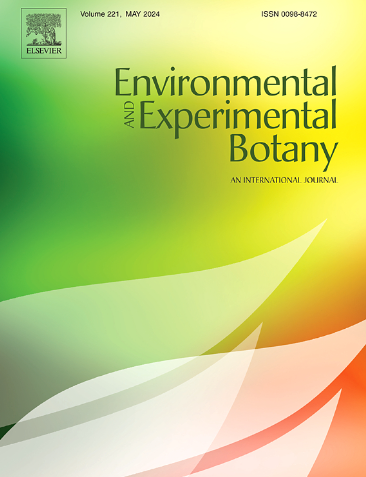Tissue expression pattern and regulatory function of ERD15 in response to UV-B signaling in Arabidopsis thaliana
IF 4.7
2区 生物学
Q2 ENVIRONMENTAL SCIENCES
引用次数: 0
Abstract
Ultraviolet B band (UV-B) radiation, as an important component of the solar radiation spectrum and a key environmental factor, can regulate the expression of numerous genes and thus affects plant growth and development. Previous studies have shown that EARLY RESPONSIVE TO DEHYDRATION 15 (ERD15), acting downstream of BBX24, is known to mediate UV-B-induced hypocotyl growth inhibition, its precise regulatory function and molecular mechanisms within UV-B signaling remain unclear. In this study, we explored the tissue-specific expression patterns and regulatory roles of ERD15 in UV-B responses at the phenotypic, physiological, and transcriptional levels, revealing the regulatory network of ERD15 involvement in UV-B signaling. GUS staining revealed that UV-B radiation significantly suppressed ERD15 expression in hypocotyls and leaves, without causing obvious changes in roots. Phenotypic and physiological assessment further demonstrated that ERD15 inhibited the enhancement of leaf photosynthetic capacity under UV-B radiation. Transcriptome analysis indicated that ERD15 modulates UV-B responses through MAPK kinase, phytohormone, and antioxidant pathways, and interacts with multiple transcription factor families. Collectively, these findings elucidated the roles of ERD15 within the UV-B signaling regulatory network, and improved the current understanding of its molecular mechanisms.
ERD15在拟南芥中响应UV-B信号的组织表达模式及调控功能
紫外线B波段(UV-B)辐射作为太阳辐射光谱的重要组成部分和关键的环境因子,可以调节多种基因的表达,从而影响植物的生长发育。先前的研究表明,作用于BBX24下游的ERD15 (EARLY RESPONSIVE TO脱水15)介导了UV-B诱导的下胚轴生长抑制,但其在UV-B信号传导中的确切调控功能和分子机制尚不清楚。在本研究中,我们从表型、生理和转录水平探讨了ERD15在UV-B应答中的组织特异性表达模式和调控作用,揭示了ERD15参与UV-B信号传导的调控网络。GUS染色显示UV-B辐射显著抑制ERD15在下胚轴和叶片中的表达,而根中ERD15的表达没有明显变化。表型和生理评价进一步表明ERD15抑制UV-B辐射下叶片光合能力的增强。转录组分析表明,ERD15通过MAPK激酶、植物激素和抗氧化途径调节UV-B反应,并与多个转录因子家族相互作用。总的来说,这些发现阐明了ERD15在UV-B信号调节网络中的作用,并改进了目前对其分子机制的理解。
本文章由计算机程序翻译,如有差异,请以英文原文为准。
求助全文
约1分钟内获得全文
求助全文
来源期刊

Environmental and Experimental Botany
环境科学-环境科学
CiteScore
9.30
自引率
5.30%
发文量
342
审稿时长
26 days
期刊介绍:
Environmental and Experimental Botany (EEB) publishes research papers on the physical, chemical, biological, molecular mechanisms and processes involved in the responses of plants to their environment.
In addition to research papers, the journal includes review articles. Submission is in agreement with the Editors-in-Chief.
The Journal also publishes special issues which are built by invited guest editors and are related to the main themes of EEB.
The areas covered by the Journal include:
(1) Responses of plants to heavy metals and pollutants
(2) Plant/water interactions (salinity, drought, flooding)
(3) Responses of plants to radiations ranging from UV-B to infrared
(4) Plant/atmosphere relations (ozone, CO2 , temperature)
(5) Global change impacts on plant ecophysiology
(6) Biotic interactions involving environmental factors.
 求助内容:
求助内容: 应助结果提醒方式:
应助结果提醒方式:


